2008 NISSAN ROGUE technical specifications
[x] Cancel search: technical specificationsPage 241 of 309
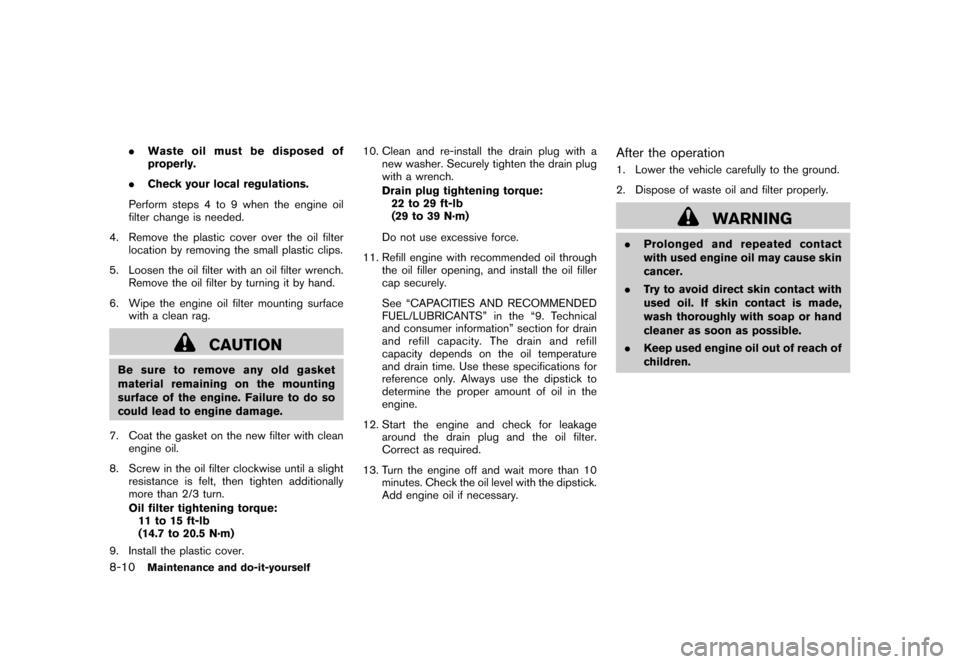
Black plate (248,1)
Model "S35-D" EDITED: 2007/ 12/ 19
.Waste oil must be disposed of
properly.
.Check your local regulations.
Perform steps 4 to 9 when the engine oil
filter change is needed.
4. Remove the plastic cover over the oil filter
location by removing the small plastic clips.
5. Loosen the oil filter with an oil filter wrench.
Remove the oil filter by turning it by hand.
6. Wipe the engine oil filter mounting surface
with a clean rag.
CAUTION
Be sure to remove any old gasket
material remaining on the mounting
surface of the engine. Failure to do so
could lead to engine damage.
7. Coat the gasket on the new filter with clean
engine oil.
8. Screw in the oil filter clockwise until a slight
resistance is felt, then tighten additionally
more than 2/3 turn.
Oil filter tightening torque:
11 to 15 ft-lb
(14.7 to 20.5 N·m)
9. Install the plastic cover.10. Clean and re-install the drain plug with a
new washer. Securely tighten the drain plug
with a wrench.
Drain plug tightening torque:
22 to 29 ft-lb
(29 to 39 N·m)
Do not use excessive force.
11. Refill engine with recommended oil through
the oil filler opening, and install the oil filler
cap securely.
See “CAPACITIES AND RECOMMENDED
FUEL/LUBRICANTS” in the “9. Technical
and consumer information” section for drain
and refill capacity. The drain and refill
capacity depends on the oil temperature
and drain time. Use these specifications for
reference only. Always use the dipstick to
determine the proper amount of oil in the
engine.
12. Start the engine and check for leakage
around the drain plug and the oil filter.
Correct as required.
13. Turn the engine off and wait more than 10
minutes. Check the oil level with the dipstick.
Add engine oil if necessary.
After the operation1. Lower the vehicle carefully to the ground.
2. Dispose of waste oil and filter properly.
WARNING
.Prolonged and repeated contact
with used engine oil may cause skin
cancer.
.Try to avoid direct skin contact with
used oil. If skin contact is made,
wash thoroughly with soap or hand
cleaner as soon as possible.
.Keep used engine oil out of reach of
children.
8-10
Maintenance and do-it-yourself
Page 272 of 309

Black plate (28,1)
9 Technical and consumer information
Model "S35-D" EDITED: 2007/ 12/ 25
Capacities and recommended fuel/lubricants............ 9-2
Fuel recommendation ...................................... 9-3
Engine oil and oil filter recommendation ............... 9-5
Air conditioning system refrigerant and lubricant
recommendations ........................................... 9-6
Specifications. ................................................... 9-7
Engine ......................................................... 9-7
Wheels and tires ............................................ 9-7
Dimensions and weights .................................. 9-8
When traveling or registering your vehicle in
another country .................................................. 9-8
Vehicle identification ........................................... 9-8
Vehicle identification number (VIN) plate .............. 9-8
Vehicle identification number (chassis number) ...... 9-9
Engine serial number ...................................... 9-9
F.M.V.S.S./C.M.V.S.S. certification label ............... 9-9
Emission control information label .................... 9-10
Tire and loading information label ..................... 9-10
Air conditioner specification label ..................... 9-10
Installing front license plate ................................ 9-11
Vehicle loading information ................................. 9-12
Terms ........................................................ 9-12 Vehicle load capacity
.................................... 9-13
Securing the load ......................................... 9-15
Loading tips ................................................ 9-16
Measurement of weights ................................ 9-16
Towing a trailer ................................................ 9-16
Maximum load limits ...................................... 9-17
Maximum gross vehicle weight (GVW)/maximum
gross axle weight (GAW) ............................... 9-18
Towing load/specification ............................... 9-20
Towing safety .............................................. 9-20
Flat towing ................................................. 9-24
Uniform tire quality grading ................................. 9-25
Treadwear .................................................. 9-25
Traction AA, A, B and C ................................ 9-25
Temperature A, B and C ................................ 9-25
Emission control system warranty ......................... 9-26
Reporting safety defects (US only) ....................... 9-26
Readiness for inspection/maintenance (I/M) test . . .... 9-26
Event data recorders (EDR) ................................ 9-27
Owner’s Manual/Service Manual order information . . . 9-28
In the event of a collision ............................... 9-28
Page 273 of 309

Black plate (282,1)
Model "S35-D" EDITED: 2007/ 12/ 19
The following are approximate capacities. The actual refill capacities may be a little different. When refilling, follow the procedure
instructed in the “8. Maintenance and do-it-yourself” section to determine the proper refill capacity.
Capacity (Approximate) Recommended specifications
US measure Imp measure Liter
Fuel 15-7/8 gal 13-1/4 gal 60 Unleaded gasoline with an octane rating of at least 87 AKI (RON 91)*1
Engine oil*2
Drain and refill
With oil filter change 4-7/8 qt 4 qt 4.6
.Engine oil with API Certification Mark*3
.Viscosity SAE 5W-30
Without oil filter change 4-1/2 qt 3-3/4 qt 4.3
Cooling system
With reservoir 7-3/4 qt 6-3/8 qt 7.3
50% Genuine NISSAN Long Life Antifreeze/Coolant or equivalent
50% Demineralized or distilled water
Reservoir 3/4 qt 5/8 qt 0.75
Continuously Variable Transmission (CVT) fluid — — — Genuine NISSAN CVT Fluid NS-2*4
Differential gear oil — — —Genuine NISSAN Differential Oil Hypoid Super GL-5 80W-90 or API GL-5 Viscosity SAE
80W-90*5
Transfer oil — — —Genuine NISSAN Differential Oil Hypoid Super GL-5 80W-90 or API GL-5 Viscosity SAE
80W-90
Brake fluidRefill to the proper oil level according to the instructions in the “8.
Maintenance and do-it-yourself” section.Genuine NISSAN Super Heavy Duty Brake Fluid*6 or equivalent DOT 3
Multi-purpose grease — — — NLGI No. 2 (Lithium soap base)
Air conditioning system refrigerant — — — HFC-134a (R-134a)*7
Air conditioning system lubricants — — — NISSAN A/C System Oil Type S or exact equivalent
Window washer fluid 1-1/6 gal 1 gal 4.5
Genuine NISSAN Windshield Washer Concentrate Cleaner & Antifreeze or equivalent
*1: For additional information, see “FUEL RECOMMENDATION” later in this section.
*2: For additional information, see “ENGINE OIL” in the “8. Maintenance and do-it-yourself” section for changing engine oil.
*3: For additional information, see “ENGINE OIL AND OIL FILTER RECOMMENDATION” later in this section.
*4:Use only Genuine NISSAN CVT Fluid NS-2. Using transmission fluid other than Genuine NISSAN CVT Fluid NS-2 will damage the CVT, which is not covered by the NISSAN new vehicle limited
warranty.
*5: For hot climates, viscosity SAE 90 is suitable for ambient temperatures above 328F(08C).
*6: Available in mainland U.S.A. through a NISSAN dealer.
*7: For additional information, see “VEHICLE IDENTIFICATION” later in this section for air conditioner specification label.
CAPACITIES AND RECOMMENDED
FUEL/LUBRICANTS9-2
Technical and consumer information
Page 274 of 309
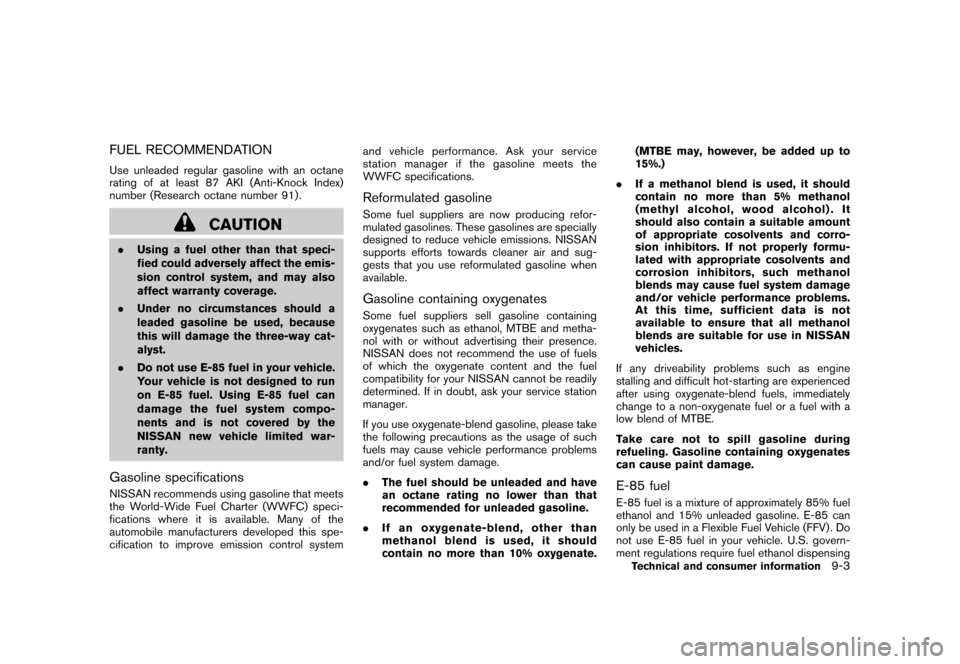
Black plate (283,1)
Model "S35-D" EDITED: 2007/ 12/ 19
FUEL RECOMMENDATIONUse unleaded regular gasoline with an octane
rating of at least 87 AKI (Anti-Knock Index)
number (Research octane number 91) .
CAUTION
.Using a fuel other than that speci-
fied could adversely affect the emis-
sion control system, and may also
affect warranty coverage.
.Under no circumstances should a
leaded gasoline be used, because
this will damage the three-way cat-
alyst.
.Do not use E-85 fuel in your vehicle.
Your vehicle is not designed to run
on E-85 fuel. Using E-85 fuel can
damage the fuel system compo-
nents and is not covered by the
NISSAN new vehicle limited war-
ranty.Gasoline specificationsNISSAN recommends using gasoline that meets
the World-Wide Fuel Charter (WWFC) speci-
fications where it is available. Many of the
automobile manufacturers developed this spe-
cification to improve emission control systemand vehicle performance. Ask your service
station manager if the gasoline meets the
WWFC specifications.
Reformulated gasolineSome fuel suppliers are now producing refor-
mulated gasolines. These gasolines are specially
designed to reduce vehicle emissions. NISSAN
supports efforts towards cleaner air and sug-
gests that you use reformulated gasoline when
available.Gasoline containing oxygenatesSome fuel suppliers sell gasoline containing
oxygenates such as ethanol, MTBE and metha-
nol with or without advertising their presence.
NISSAN does not recommend the use of fuels
of which the oxygenate content and the fuel
compatibility for your NISSAN cannot be readily
determined. If in doubt, ask your service station
manager.
If you use oxygenate-blend gasoline, please take
the following precautions as the usage of such
fuels may cause vehicle performance problems
and/or fuel system damage.
.The fuel should be unleaded and have
an octane rating no lower than that
recommended for unleaded gasoline.
.If an oxygenate-blend, other than
methanol blend is used, it should
contain no more than 10% oxygenate.(MTBE may, however, be added up to
15%.)
.If a methanol blend is used, it should
contain no more than 5% methanol
(methyl alcohol, wood alcohol) . It
should also contain a suitable amount
of appropriate cosolvents and corro-
sion inhibitors. If not properly formu-
lated with appropriate cosolvents and
corrosion inhibitors, such methanol
blends may cause fuel system damage
and/or vehicle performance problems.
At this time, sufficient data is not
available to ensure that all methanol
blends are suitable for use in NISSAN
vehicles.
If any driveability problems such as engine
stalling and difficult hot-starting are experienced
after using oxygenate-blend fuels, immediately
change to a non-oxygenate fuel or a fuel with a
low blend of MTBE.
Take care not to spill gasoline during
refueling. Gasoline containing oxygenates
can cause paint damage.
E-85 fuelE-85 fuel is a mixture of approximately 85% fuel
ethanol and 15% unleaded gasoline. E-85 can
only be used in a Flexible Fuel Vehicle (FFV) . Do
not use E-85 fuel in your vehicle. U.S. govern-
ment regulations require fuel ethanol dispensing
Technical and consumer information
9-3
Page 278 of 309

Black plate (287,1)
Model "S35-D" EDITED: 2007/ 12/ 19
ENGINEModel QR25DE
Type Gasoline, 4-cycle, DOHC
Cylinder arrangement 4-cylinder, in-line
Bore6Stroke in (mm) 3.563.9 (89.06100.0)
Displacement cu in (cm
3) 151.82 (2,488)
Firing order 1-3-4-2
Idle speed rpm
No adjustment is necessary.
Ignition timing (B.T.D.C.) degree/rpm
Spark plug Standard DILKAR6A-11
Spark plug gap (Normal) in (mm) 0.043 (1.1)
Camshaft operation
Timing chain
This spark ignition system complies with the Canadian standard ICES-002.
WHEELS AND TIRES
Road wheelType Size Offset in (mm)
Steel 1666-1/2JJ 1.57 (40)
Aluminum 1767J 1.57 (40)
T-type 1664T
1.18 (30)TireType SizePressure PSI
(kPa) [Cold]
ConventionalP215/70R16
99H
33 (230)
P225/60R17
98H
T-typeT155/90D16
60 (420)
SPECIFICATIONS
Technical and consumer information
9-7
Page 279 of 309
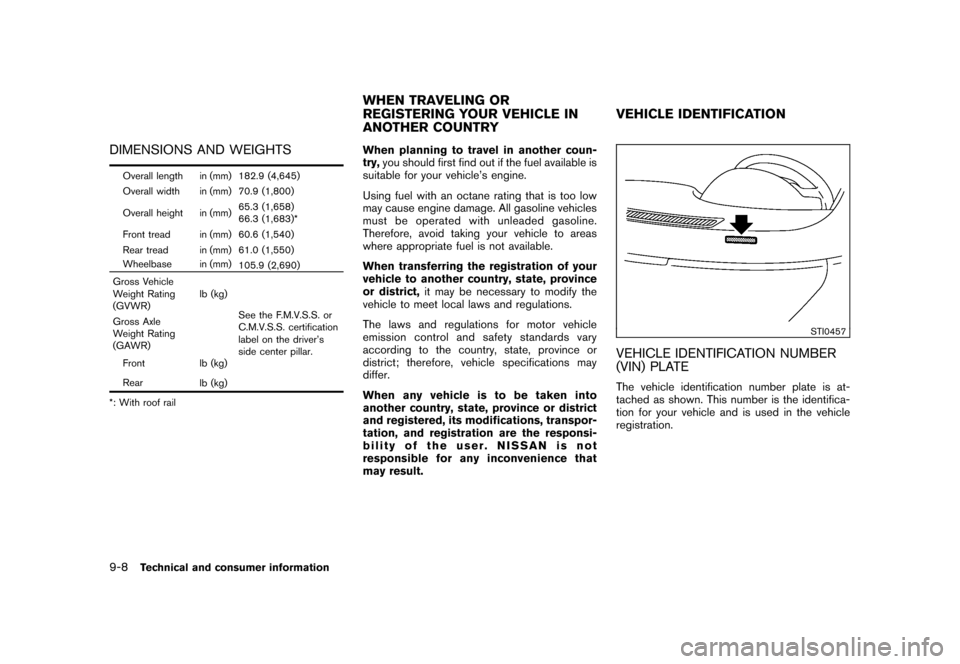
Black plate (288,1)
Model "S35-D" EDITED: 2007/ 12/ 19
DIMENSIONS AND WEIGHTSOverall length in (mm) 182.9 (4,645)
Overall width in (mm) 70.9 (1,800)
Overall height in (mm)65.3 (1,658)
66.3 (1,683)*
Front tread in (mm) 60.6 (1,540)
Rear tread in (mm) 61.0 (1,550)
Wheelbase in (mm)
105.9 (2,690)
Gross Vehicle
Weight Rating
(GVWR)lb (kg)
See the F.M.V.S.S. or
C.M.V.S.S. certification
label on the driver’s
side center pillar. Gross Axle
Weight Rating
(GAWR)
Front lb (kg)
Rear
lb (kg)
*: With roof rail
When planning to travel in another coun-
try,you should first find out if the fuel available is
suitable for your vehicle’s engine.
Using fuel with an octane rating that is too low
may cause engine damage. All gasoline vehicles
must be operated with unleaded gasoline.
Therefore, avoid taking your vehicle to areas
where appropriate fuel is not available.
When transferring the registration of your
vehicle to another country, state, province
or district,it may be necessary to modify the
vehicle to meet local laws and regulations.
The laws and regulations for motor vehicle
emission control and safety standards vary
according to the country, state, province or
district; therefore, vehicle specifications may
differ.
When any vehicle is to be taken into
another country, state, province or district
and registered, its modifications, transpor-
tation, and registration are the responsi-
bility of the user. NISSAN is not
responsible for any inconvenience that
may result.
STI0457
VEHICLE IDENTIFICATION NUMBER
(VIN) PLATEThe vehicle identification number plate is at-
tached as shown. This number is the identifica-
tion for your vehicle and is used in the vehicle
registration.
WHEN TRAVELING OR
REGISTERING YOUR VEHICLE IN
ANOTHER COUNTRYVEHICLE IDENTIFICATION
9-8
Technical and consumer information
Page 292 of 309
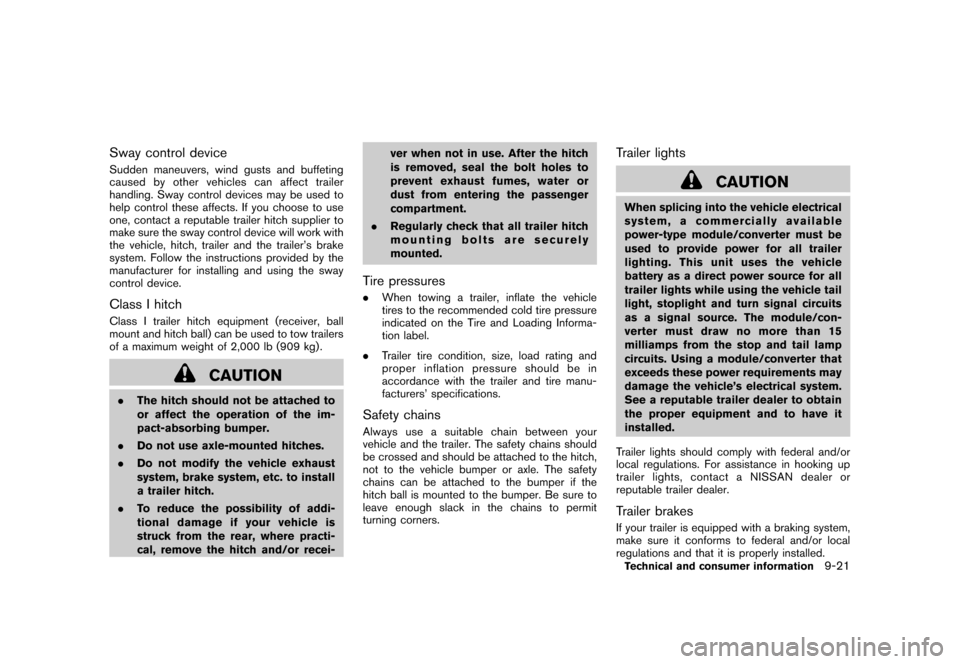
Black plate (301,1)
Model "S35-D" EDITED: 2007/ 12/ 19
Sway control deviceSudden maneuvers, wind gusts and buffeting
caused by other vehicles can affect trailer
handling. Sway control devices may be used to
help control these affects. If you choose to use
one, contact a reputable trailer hitch supplier to
make sure the sway control device will work with
the vehicle, hitch, trailer and the trailer’s brake
system. Follow the instructions provided by the
manufacturer for installing and using the sway
control device.Class I hitchClass I trailer hitch equipment (receiver, ball
mount and hitch ball) can be used to tow trailers
of a maximum weight of 2,000 lb (909 kg) .
CAUTION
.The hitch should not be attached to
or affect the operation of the im-
pact-absorbing bumper.
.Do not use axle-mounted hitches.
.Do not modify the vehicle exhaust
system, brake system, etc. to install
a trailer hitch.
.To reduce the possibility of addi-
tional damage if your vehicle is
struck from the rear, where practi-
cal, remove the hitch and/or recei-ver when not in use. After the hitch
is removed, seal the bolt holes to
prevent exhaust fumes, water or
dust from entering the passenger
compartment.
.Regularly check that all trailer hitch
mounting bolts are securely
mounted.
Tire pressures.When towing a trailer, inflate the vehicle
tires to the recommended cold tire pressure
indicated on the Tire and Loading Informa-
tion label.
.Trailer tire condition, size, load rating and
proper inflation pressure should be in
accordance with the trailer and tire manu-
facturers’ specifications.Safety chainsAlways use a suitable chain between your
vehicle and the trailer. The safety chains should
be crossed and should be attached to the hitch,
not to the vehicle bumper or axle. The safety
chains can be attached to the bumper if the
hitch ball is mounted to the bumper. Be sure to
leave enough slack in the chains to permit
turning corners.
Trailer lights
CAUTION
When splicing into the vehicle electrical
system, a commercially available
power-type module/converter must be
used to provide power for all trailer
lighting. This unit uses the vehicle
battery as a direct power source for all
trailer lights while using the vehicle tail
light, stoplight and turn signal circuits
as a signal source. The module/con-
verter must draw no more than 15
milliamps from the stop and tail lamp
circuits. Using a module/converter that
exceeds these power requirements may
damage the vehicle’s electrical system.
See a reputable trailer dealer to obtain
the proper equipment and to have it
installed.
Trailer lights should comply with federal and/or
local regulations. For assistance in hooking up
trailer lights, contact a NISSAN dealer or
reputable trailer dealer.Trailer brakesIf your trailer is equipped with a braking system,
make sure it conforms to federal and/or local
regulations and that it is properly installed.Technical and consumer information
9-21
Page 299 of 309
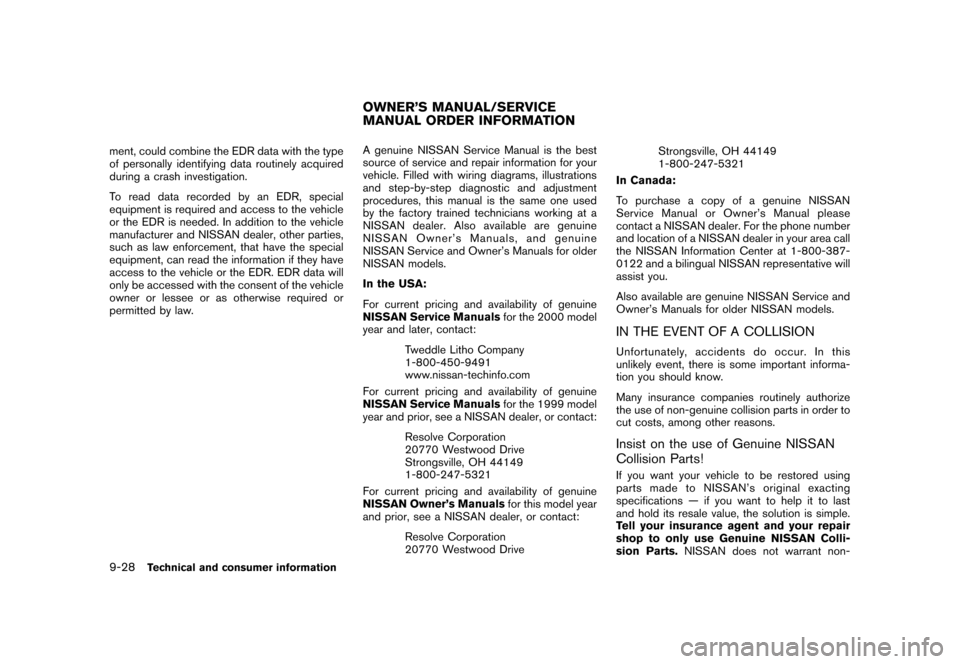
Black plate (308,1)
Model "S35-D" EDITED: 2007/ 12/ 19
ment, could combine the EDR data with the type
of personally identifying data routinely acquired
during a crash investigation.
To read data recorded by an EDR, special
equipment is required and access to the vehicle
or the EDR is needed. In addition to the vehicle
manufacturer and NISSAN dealer, other parties,
such as law enforcement, that have the special
equipment, can read the information if they have
access to the vehicle or the EDR. EDR data will
only be accessed with the consent of the vehicle
owner or lessee or as otherwise required or
permitted by law.A genuine NISSAN Service Manual is the best
source of service and repair information for your
vehicle. Filled with wiring diagrams, illustrations
and step-by-step diagnostic and adjustment
procedures, this manual is the same one used
by the factory trained technicians working at a
NISSAN dealer. Also available are genuine
NISSAN Owner’s Manuals, and genuine
NISSAN Service and Owner’s Manuals for older
NISSAN models.
In the USA:
For current pricing and availability of genuine
NISSAN Service Manualsfor the 2000 model
year and later, contact:
Tweddle Litho Company
1-800-450-9491
www.nissan-techinfo.com
For current pricing and availability of genuine
NISSAN Service Manualsfor the 1999 model
year and prior, see a NISSAN dealer, or contact:
Resolve Corporation
20770 Westwood Drive
Strongsville, OH 44149
1-800-247-5321
For current pricing and availability of genuine
NISSAN Owner’s Manualsfor this model year
and prior, see a NISSAN dealer, or contact:
Resolve Corporation
20770 Westwood DriveStrongsville, OH 44149
1-800-247-5321
In Canada:
To purchase a copy of a genuine NISSAN
Service Manual or Owner’s Manual please
contact a NISSAN dealer. For the phone number
and location of a NISSAN dealer in your area call
the NISSAN Information Center at 1-800-387-
0122 and a bilingual NISSAN representative will
assist you.
Also available are genuine NISSAN Service and
Owner’s Manuals for older NISSAN models.
IN THE EVENT OF A COLLISIONUnfortunately, accidents do occur. In this
unlikely event, there is some important informa-
tion you should know.
Many insurance companies routinely authorize
the use of non-genuine collision parts in order to
cut costs, among other reasons.Insist on the use of Genuine NISSAN
Collision Parts!If you want your vehicle to be restored using
parts made to NISSAN’s original exacting
specifications — if you want to help it to last
and hold its resale value, the solution is simple.
Tell your insurance agent and your repair
shop to only use Genuine NISSAN Colli-
sion Parts.NISSAN does not warrant non-
OWNER’S MANUAL/SERVICE
MANUAL ORDER INFORMATION
9-28
Technical and consumer information